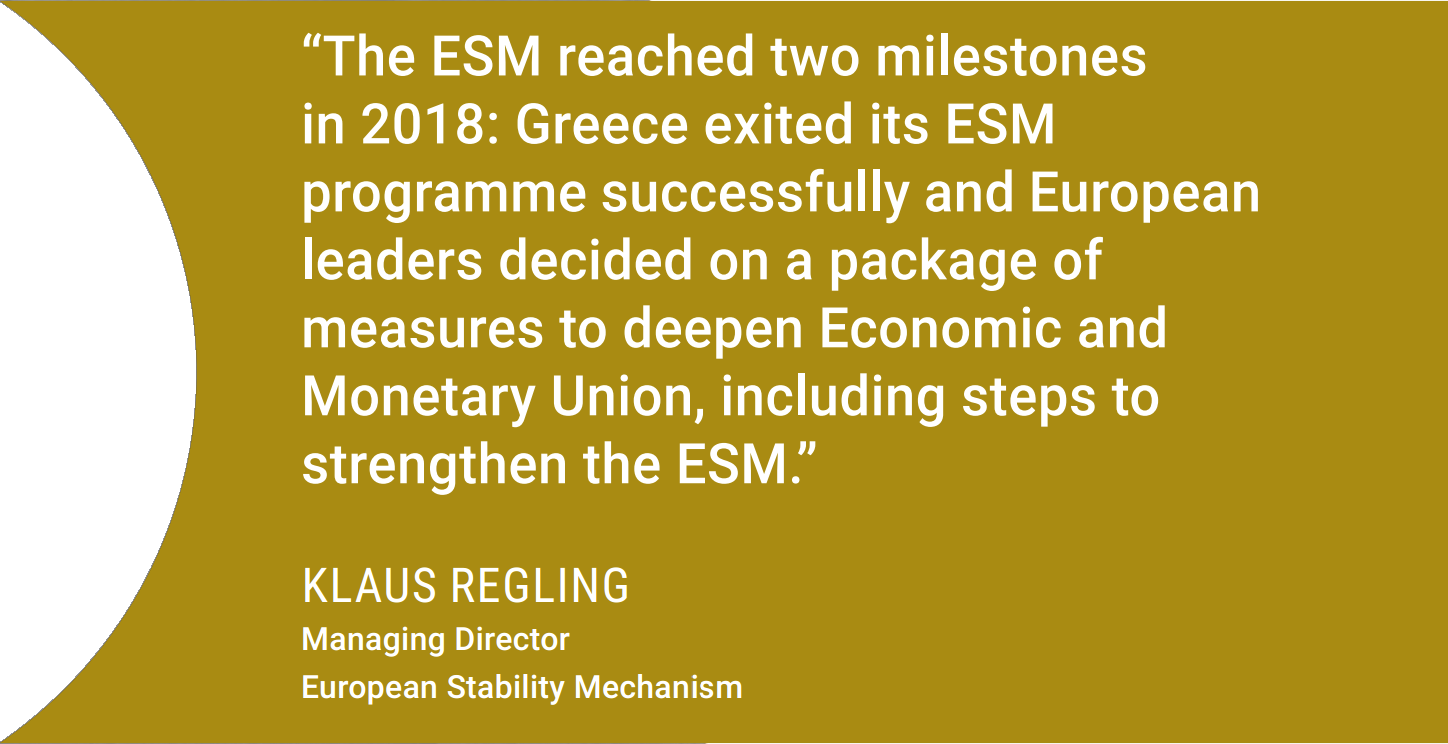Message from the Managing Director
Message from the Managing Director
The ESM reached two milestones in 2018: Greece exited its ESM programme successfully in August after more than eight years under financial assistance, and the Euro Summit decided in December on a package of measures to deepen Economic and Monetary Union (EMU), including steps to strengthen the ESM.
Greece’s successful programme exit followed those of Ireland, Spain, Cyprus, and Portugal. With loans of almost €204 billion from the ESM and its temporary predecessor, the EFSF, Greece has benefited from the largest financial assistance in modern history, making the rescue funds the country’s biggest creditor by far. Thanks to our loans’ low interest rates and long maturities, Greece saved €13 billion in its 2018 budget alone compared to market financing, calculations for this Annual report show. This amount represents 7% of Greek GDP. Similar savings will be repeated over many years to come. This is an unprecedented act of solidarity by the other euro area member states with Greece.
In a further gesture of support, the Eurogroup approved medium-term debt relief measures for Greece in June. They concern an abolition of step-up interest rate margins, a further 10-year deferral of interest and amortisation, and a 10-year extension of the maximum weighted average maturity, all related to EFSF loans. We estimate that this will lead to a cumulative reduction of Greece’s debt-to-GDP ratio of around 30 percentage points until 2060. We also expect Greece’s gross financing needs to fall by around eight percentage points over the same time horizon. As a result of these medium-term measures, Greece will not start repaying most of its EFSF loans before 2033, and the new weighted average loan maturity has been extended to 42.5 years. All of this comes on top of sizeable short-term debt relief measures implemented in 2017 for Greece.

Also for the longer term, Greece received reassurance on its debt sustainability. The euro finance ministers committed to reviewing in 2032 whether additional debt measures are needed to respect Greece’s agreed gross financing needs targets. There is also a contingency mechanism on debt, which could be activated should Greece be hit by an unexpectedly adverse scenario. If the Eurogroup were to activate the mechanism, measures could include further re-profiling, and capping and deferral of interest payments to the EFSF to the extent needed to meet the gross financing needs targets.
In return, Greece pledged to stick to the reforms agreed under the programme, among them to maintain a primary surplus of 3.5% until 2022 and to comply with EU rules, particularly related to fiscal and economic policies.
In an effort to continuously improve the work of the ESM, Mário Centeno, the Chairperson of the ESM Board of Governors, and I have asked former European Commission Vice President Joaquín Almunia to lead an independent evaluation of the financial assistance to Greece. We are looking forward to an interim report of his work in December 2019 and to the opportunity to consider his results at the ESM Board of Governors’ Annual Meeting in June 2020.
With Greece’s programme exit, the ESM accomplished its immediate mission to overcome the euro crisis and to safeguard financial stability in the euro area by providing loans in exchange for economic policy reforms. The ESM can now focus on implementing the December Euro Summit decisions to be better prepared for the next crisis.
The year-end summit decisions illustrate both Europe’s determination to make the euro area more resilient and the political will to move EMU forward even without the threat of an existential crisis. The decisions also show that the ESM has become a key pillar in the currency union’s institutional architecture.

According to the Euro Summit, the ESM receives a broadened mandate and becomes the backstop for bank resolution within banking union. This backstop will only be activated if the funds of the Single Resolution Fund are insufficient to resolve a bank in crisis. To repay its loans to the ESM within three-to-five years, the SRF would receive levies from European banks. As is the case with all country programmes, there will be no transfer of taxpayers’ money. By 2024 at the latest, the backstop will be fully operational.
The ESM will also play a stronger role in future programmes in close cooperation with the European Commission and in full respect of its prerogatives according to the EU Treaty. Together with the Commission, the ESM will design, negotiate, and monitor future programmes. Building on the Memorandum of Understanding (MoU) signed in April 2018, the ESM and the Commission agreed in November on their future cooperation and the Euro Summit endorsed the agreement. The two institutions will work in tandem, drawing strength from the complementarity of our respective expertise.
Additionally, the Euro Summit decided to make the ESM precautionary credit lines more efficient and easier to use, and to strengthen the role of the ESM in matters of debt sustainability. It is the ESM’s role to take a creditor’s perspective. In the future, the Commission and the ESM will jointly prepare a debt sustainability analysis for programme countries. In addition, when appropriate, and if requested by the Member State, the ESM may facilitate the dialogue between its Members and private investors. This involvement would take place on a voluntary, informal, non-binding, temporary, and confidential basis.
Furthermore, the euro area intends to introduce single limb collective action clauses by 2022 and to include this commitment in the ESM Treaty. These Euro Summit decisions are not intended to lead to more debt restructurings but to more transparency and predictability.
Lastly, the summit mandated the Eurogroup to work in two areas where Member States still have very different views: a common European deposit insurance scheme and a budgetary instrument for convergence and competitiveness of the area.
We know that a European deposit insurance is important for the completion of banking union. Views diverge on the preconditions needed, but it would ultimately be very beneficial to overcome the fragmentation of Europe’s financial markets. Also, the past ESM and EFSF programmes would have been much smaller if we had had a common deposit insurance.
Regarding the euro area budget, the summit asked the finance ministers to work on the design, the modalities of implementation, and the timing of the budgetary instrument for convergence and competitiveness. This is a positive step as it will encourage structural reforms and strengthen competitiveness in the euro member states. This will enhance the resilience of the monetary union as a whole.
I also see good economic reasons to talk about fiscal instruments for macroeconomic stabilisation. There are several proposals on the table that would not lead to permanent transfers. Following the European elections, I would welcome broadening the discussion. We could also consider a revision of the fiscal rules, to make them more effective, and a stabilisation facility at the euro area level operating outside a crisis situation. But this is beyond the current political mandate.
The efforts to deepen EMU and enhance its resilience, together with the completion of banking union and capital markets union, would also help to strengthen the international role of the euro. A more balanced multipolar currency system that comprises the US dollar, the euro, the renminbi, and perhaps one or two other currencies would, over time, improve the functioning of the international monetary system and protect Europe’s interests.












